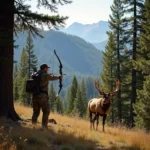Have you ever wondered what the world looks like through the eyes of a horse? As majestic and intelligent as these creatures are, their vision differs significantly from ours. Understanding how horses perceive color can help us better understand their behavior and provide a safer, more enriching environment for them. While horses may not see the world in the same vibrant hues that we do, their vision is uniquely adapted to their needs. Let’s delve into the fascinating world of equine vision and answer the question: what color can horses see?
Decoding the Horse’s Color Spectrum: Dichromatic Vision
Unlike humans who have trichromatic vision, meaning we perceive colors through three types of cone cells in our eyes, horses have dichromatic vision. They possess only two types of cones, similar to humans with red-green color blindness. This means their ability to differentiate colors is limited compared to ours.
Blue and Green: The Dominant Hues in a Horse’s World
So, what colors can horses see clearly? Horses can see shades of blue and green most vibrantly. This means they can easily perceive variations within these color families. However, their ability to see other colors, such as red and orange, is limited.
 Horse Grazing in a Field
Horse Grazing in a Field
Seeing the World in Shades of Gray: How Horses Perceive Other Colors
While horses struggle to distinguish reds and oranges, they are not completely colorblind to these hues. Instead, they likely see these colors as shades of gray or brown. This limited color perception explains why red objects may appear duller or less distinct to a horse than a similar object in green or blue.
The Impact of Limited Color Vision on Horse Behavior
Understanding a horse’s limited color vision can help us interact with them more effectively and ensure their well-being:
- Training and Handling: Using equipment and training aids in shades of blue or green can enhance visibility and communication. Conversely, using red or orange equipment might be less effective, as these colors may not stand out as clearly to the horse.
- Environmental Safety: When designing stables, paddocks, or jumps, it’s important to consider color contrasts. Using highly contrasting colors, like blue and white or green and white, can help horses perceive their surroundings better and avoid potential hazards.
- Understanding Reactions: If a horse seems startled or hesitant around a particular object or area, it might be due to its limited color perception. By being aware of this, we can approach such situations with patience and understanding.
 Horse Jumping over Blue and White Obstacle
Horse Jumping over Blue and White Obstacle
Beyond Color: The Strengths of Equine Vision
While horses might have limited color vision, their overall eyesight is incredibly well-suited to their needs.
- Exceptional Night Vision: Horses have larger eyes and more rod cells (responsible for seeing in low light) than humans, giving them excellent night vision. They can navigate dimly lit environments with ease, a crucial advantage for a prey animal.
- Wide Field of Vision: Their laterally placed eyes provide a wide field of vision, allowing them to see almost 360 degrees around them. This panoramic vision helps them detect predators and navigate their surroundings effectively.
Conclusion: Appreciating the Uniqueness of Equine Vision
Understanding that horses see the world differently than us fosters a deeper appreciation for these magnificent animals. By acknowledging their unique visual perception, we can create a safer and more enriching environment that caters to their needs and strengthens the bond we share with them. So, the next time you interact with a horse, remember their world might be painted in different hues, but their ability to perceive and navigate their surroundings is nothing short of remarkable.
FAQs
- Can horses see in the dark?
Yes, horses have excellent night vision due to a higher number of rod cells in their eyes. They can see much better in low light conditions than humans. - Why do horses shy away from certain objects?
Horses might shy away from objects due to their limited color vision, perceiving them differently than we do, or because of sudden movements. - What colors are best for horse jumps?
Using highly contrasting colors like blue and white or green and white helps horses perceive jumps clearly.
Do you have other questions about horse vision or need assistance with color selection for your equine spaces?
Contact us at:
Phone Number: 0373298888
Email: SEO.backlink@gmail.com
Address: 86 Cầu Giấy, Hà Nội
Our dedicated team is available 24/7 to provide expert guidance and support.

